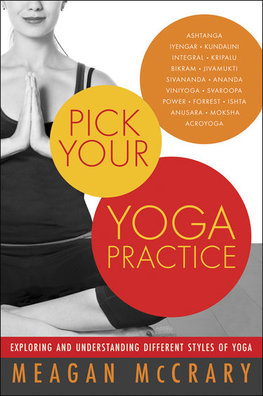 I have to admit, when I was first approached about doing a book review for new book about the different types of yoga, I was a little hesitant. My inner skeptic thought, "But there's already so many out there!" Trying to employ my good yogi skills, I set aside my expectations and judgements, and cracked the book with an open mind and heart. I'm so glad I did. When we actively work to break our patterns of judgement and negative thought, it's amazing how much of the world opens up. This is certainly true of my experience with Pick Your Yoga Practice. Here Meagan McCrary, a certified yoga instructor and journalist explores seven of the most prominent approaches, plus ten “best of the rest,” in terms of what a class is like, the level of physical exertion involved, and the philosophical and spiritual underpinnings. McCrary’s approach digs deeper than the physical descriptions of the practices to include everything from a style’s philosophical foundation and teaching methodology to what-to-expect and health benefits. It's these more in-depth philosophical descriptions that really grabbed my attention. As a teacher, I regularly try to study and share these lessons with my students. And often there is a connection to what is going on in my life or the rhythm of the season, to what we work on in class. But translating these concepts to a diverse population can be challenging at times. We are all at our own place in our practice, and not everyone wants to hear about Ahimsa and Sankalpa. And that's okay! McCrary presents some very clear and accessible jewels about yoga philosophy, that are easy to understand (and share with others), but also draw your attention to keep the book engaging. Like her description of the Six Poisons Surrounding the Spiritual Heart. Doesn't the heading make you want to find out what that is??! So it's not really just a book about different yoga styles. It encompasses a lot more than that, and is a great resource for anyone looking to start a practice, or someone who just wants to look at it with fresh eyes. And just like it's important to approach things with an open heart, the same is true for thinking about them with a beginner's mind. namaste friends, Kristin  Meagan McCrary is a Los Angeles based yoga teacher and the author of Pick Your Yoga Practice. She teaches for Equinox Sports Clubs, works one-on-one with some of the entertainment industries leading professionals, and holds workshops and retreats nationally and internationally. Visit her online at http://www.meaganmccrary.com.
3 Comments
Did you make a resolution as the clocked ticked down to 2014?
While New Year's Resolutions are a common tradition, so are the guilt and shame that follow when your unrealistic resolutions don't hold up in the long run. These negative thoughts and feelings result in low self-esteem and more self-deprecating behavior and unhealthy habits. Instead of following that same vicious cycle year after year, why not break your pattern and start with the basics? Send yourself a little love. Ahimsa is one of the first yogic principles, and it's one of the most important. While it is more commonly translated as non-violence, it can be thought of as positive thoughts and feelings as well. What we think of ourselves or others can be just as harmful as a physical attempt to harm. So do yourself a favor, and congratulate yourself on just how spectacular you already are. Go ahead....... When we look at ourselves in that light we are better able to set our intentions. For our practice, our day, or the new year. In Yoga, this intention setting or resolution is known as Sankalpa. It's a will, a purpose, or determination. But it is done in a way that does not focus on the negative, which is unfortunately often tied into our traditional resolutions. Here's some examples: "I'm going to lose 15 pounds!" Translation: "I'm really fat." "I'm going to stop drinking coffee!" Translation: "I'm really unhealthy." "I"m going to be more patient." Translation: "I'm a terrible person for getting frustrated." Sankalkpa encourages you to look behind that thought. So instead of those traditional resolutions, why not focus on "Learning what foods make your body feel the best", or "Recognizing a craving when it occurs and giving it time to pass." Sankalpa allows us to surrender to our intentions, instead of forcing them, and open ourselves to the universe. Happy New Year Friends! Hope yours is filled with love and light! Kristin |
AuthorI am constantly amazed by the healing power of yoga and herbs. They inspire me to heal, to write, to teach, and to keep exploring. Archives
January 2017
Categories
All
|

 RSS Feed
RSS Feed

